Wearing heels shoes creates stress and strain on the hamstrings, knees, shoulders, neck, and back by forcing the pelvis to dip forward and the butt to rotate back.

If you think about walking in true high heels (if you're a guy, you'll have to use your imagination), you know that if you don't adjust how you stand, you'll fall forward, flat on your face. That's because high heels lean you forward. Just watch little kids playing dress-up in high heels. They lean forward (and often fall).

⇧ She needs support to balance on high heels.
To stay upright in high heels, you need to lean back. The way your body adapts to this lean is to hinge at the waist and kick your butt back. In anatomical terms, you're rotating your pelvis forward. This shifts your center of gravity back and keeps you from falling forward. It's also why some people think high heels make women look more shapely, because they have to adjust with their derrieres.








Now, whether it is a true high heel or a running or walking shoe doesn't make a difference: when your heel is higher than your forefoot, you need to adjust how you stand so you don't fall forward on your face. It's another telling argument for getting rid of all those hazardous high-heeled shoes.

For every inch your heels are up off the ground, you are tilting your pelvis forward at least 10 to 15 degrees. Stand up and try it. See what we mean?

This kind of change in our human anatomy. how we stand, is highly significant in terms of the body. And it is unnatural.
Your body works as a kinetic chain, or a series of movements, each one affecting the next. If you think of the body as a series of interconnected links in a chain, you must move one link before the next, and if one of them is out of position, it can disrupt the smoothness of the chain. When you rotate the pelvis forward to compensate for a high heel, for example, you cause several detrimental changes to how you stand and walk.
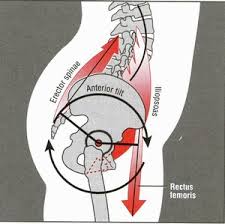


Just look at the arched back and pooched belly on the woman on the far right (C) in the diagram above.
First, your pelvis pulls on your back and hamstrings. If you've ever gotten tight hamstrings ( the muscles on the upper back of your thighs) while you walk, it's because of the tilt in your pelvis. More often than not, it pulls on your knees and lower back muscles, making them sore as you walk, stand, or move throughout the day or night, while on high heels.

Believe it or not, this also affects your upper back, shoulders, and neck, because as you lean forward, your back, shoulders, and neck are forced to do the work of holding you up. They become fatigued and strained.

In a sense, it is as if you've attached a weight to your neck by a string. As you lean forward it pulls on your neck, straining your entire neck, back, and shoulder throughout the day and night. If you could stand truly upright, the strain would go away. Unfortunately, so would your balance in a typical shoe.
It also causes you to lean forward, putting more pressure on your thighs, knees, and even feet. This awkward posture is sure to fatigue you. It will make you sorer as you walk. It also makes you less stable and more likely to fall. No wonder you want to intuitively kick off your shoes when you come home from work or the pain is unbearable.

⇧Note the even weight distribution throughout your foot while standing barefoot versus wearing a shoe with a heel. The greater the difference in weight distribution, the greater the chance of injury and feet deformity.⇩

One final point on posture : when you lean forward, you are squashing your poor feet in shoes. Leaning body forward puts extra pressure on your feet, which are trapped in shoes. Even in well-fitting shoe, if you're leaning forward, you are pushing your feet forward, smashing your toes right into the toe box of your shoes.






⇯A is heel to forefoot (X), ⇧B is forefoot to heel. (✔)

Chances are , unless you've been in sandals or barefoot walking/running your whole life so far, your feet are telling a tale. Take off your shoes, if your are wearing one pair now, and look at your toes. The big toes should not touch the second toe, and there should be spacing between the toes.
Injuries and misshapen toes have two (2) main sources:
a shoe that 's too tight and small for the foot and leaning forward and jamming your foot into the front of a shoe. Foot problems are NOT CAUSED by genetics, as some people think. You do not have to have bunions or squished toes.




Overtime, you can positively change the shape of your foot. The only thing you can blame on Mom and Dad is what they made you wear as an infant and how they influenced the type of shoes you wore as a child and perhaps even as an adult. Mom and Dad likely put you in the same type of shoes they wore.
How far your feet can go toward returning to normal depends on the amount of time and dedication you want to put into it, but you can get your feet looking and working better. And they will feel better too. Happy Feet.

If you think about walking in true high heels (if you're a guy, you'll have to use your imagination), you know that if you don't adjust how you stand, you'll fall forward, flat on your face. That's because high heels lean you forward. Just watch little kids playing dress-up in high heels. They lean forward (and often fall).
⇧ She needs support to balance on high heels.
To stay upright in high heels, you need to lean back. The way your body adapts to this lean is to hinge at the waist and kick your butt back. In anatomical terms, you're rotating your pelvis forward. This shifts your center of gravity back and keeps you from falling forward. It's also why some people think high heels make women look more shapely, because they have to adjust with their derrieres.
Now, whether it is a true high heel or a running or walking shoe doesn't make a difference: when your heel is higher than your forefoot, you need to adjust how you stand so you don't fall forward on your face. It's another telling argument for getting rid of all those hazardous high-heeled shoes.
For every inch your heels are up off the ground, you are tilting your pelvis forward at least 10 to 15 degrees. Stand up and try it. See what we mean?
This kind of change in our human anatomy. how we stand, is highly significant in terms of the body. And it is unnatural.
Your body works as a kinetic chain, or a series of movements, each one affecting the next. If you think of the body as a series of interconnected links in a chain, you must move one link before the next, and if one of them is out of position, it can disrupt the smoothness of the chain. When you rotate the pelvis forward to compensate for a high heel, for example, you cause several detrimental changes to how you stand and walk.
Just look at the arched back and pooched belly on the woman on the far right (C) in the diagram above.
First, your pelvis pulls on your back and hamstrings. If you've ever gotten tight hamstrings ( the muscles on the upper back of your thighs) while you walk, it's because of the tilt in your pelvis. More often than not, it pulls on your knees and lower back muscles, making them sore as you walk, stand, or move throughout the day or night, while on high heels.
Believe it or not, this also affects your upper back, shoulders, and neck, because as you lean forward, your back, shoulders, and neck are forced to do the work of holding you up. They become fatigued and strained.
In a sense, it is as if you've attached a weight to your neck by a string. As you lean forward it pulls on your neck, straining your entire neck, back, and shoulder throughout the day and night. If you could stand truly upright, the strain would go away. Unfortunately, so would your balance in a typical shoe.
It also causes you to lean forward, putting more pressure on your thighs, knees, and even feet. This awkward posture is sure to fatigue you. It will make you sorer as you walk. It also makes you less stable and more likely to fall. No wonder you want to intuitively kick off your shoes when you come home from work or the pain is unbearable.
⇧Note the even weight distribution throughout your foot while standing barefoot versus wearing a shoe with a heel. The greater the difference in weight distribution, the greater the chance of injury and feet deformity.⇩
One final point on posture : when you lean forward, you are squashing your poor feet in shoes. Leaning body forward puts extra pressure on your feet, which are trapped in shoes. Even in well-fitting shoe, if you're leaning forward, you are pushing your feet forward, smashing your toes right into the toe box of your shoes.
⇯A is heel to forefoot (X), ⇧B is forefoot to heel. (✔)
Chances are , unless you've been in sandals or barefoot walking/running your whole life so far, your feet are telling a tale. Take off your shoes, if your are wearing one pair now, and look at your toes. The big toes should not touch the second toe, and there should be spacing between the toes.
Injuries and misshapen toes have two (2) main sources:
a shoe that 's too tight and small for the foot and leaning forward and jamming your foot into the front of a shoe. Foot problems are NOT CAUSED by genetics, as some people think. You do not have to have bunions or squished toes.
Overtime, you can positively change the shape of your foot. The only thing you can blame on Mom and Dad is what they made you wear as an infant and how they influenced the type of shoes you wore as a child and perhaps even as an adult. Mom and Dad likely put you in the same type of shoes they wore.
How far your feet can go toward returning to normal depends on the amount of time and dedication you want to put into it, but you can get your feet looking and working better. And they will feel better too. Happy Feet.

No comments:
Post a Comment